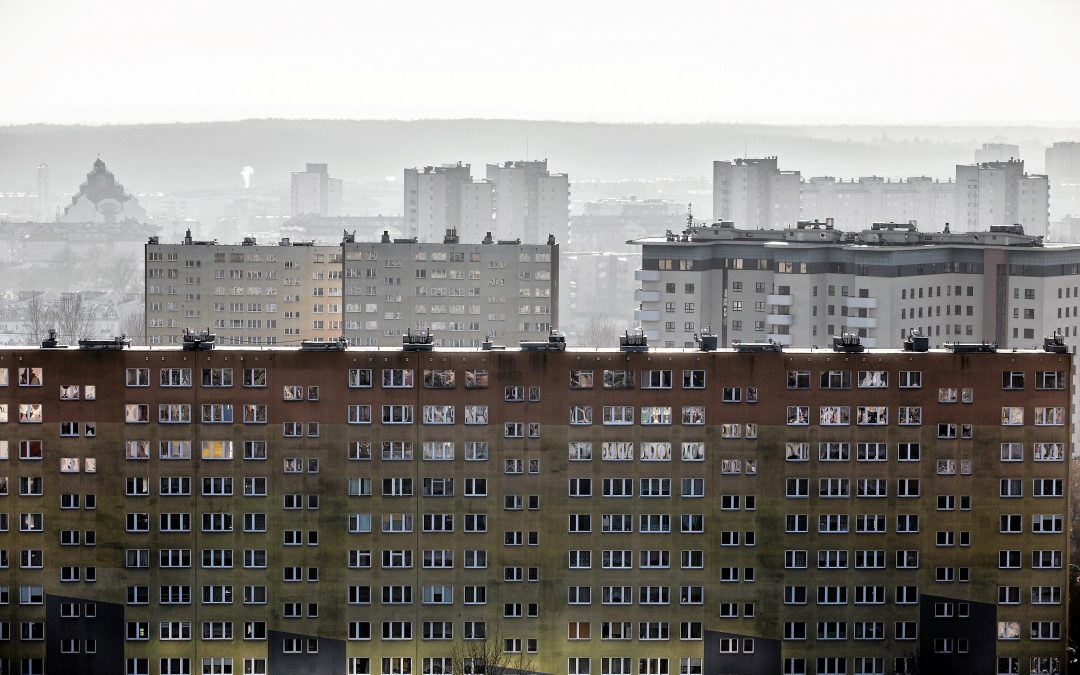By Alicja Ptak
The birth of Gdynia in 1926 attracted global interest. Journalists from some of the world’s biggest newspapers and magazines flocked to the newly established coastal city to see the flagship project of interwar Poland.
A National Geographic reporter wrote at the time that “Poland dreams of building her New York”. More than a decade later, enthusiasm had still not waned, and Wiadomości Literackie, a prestigious Polish socio-cultural weekly, published a visualisation of what Gdynia might look like in the year 2000.
The photo showed a Manhattan-like skyline, with skyscrapers clustered by the shore and a ship sailing towards the viewer. Black smoke rose from its chimney, a symbol of industrial potential that did not age well.
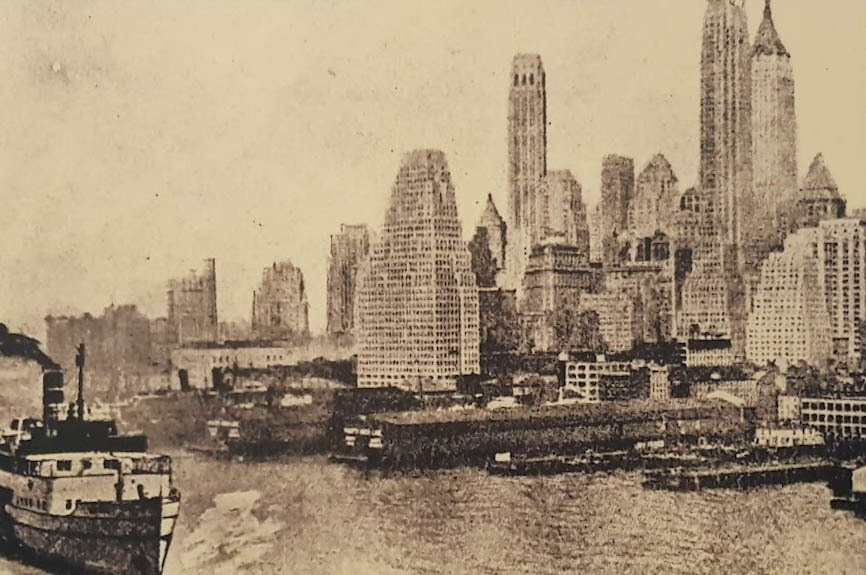
Gdynia in the year 2000, visualised by Marian Eile-Krzemieniewski, the first editor of the weekly Przekrój published in Wiadomości Literackie, No. 21, 1937 Gdynia City Museum
It has been 85 years, and while Gdynia looks nothing like what Wiadomości Literackie imagined, its visual history seems to mirror that of Poland.
“Pastelitis”
The enthusiasm of Gdynia’s early days produced its iconic modernism, a local take on the European architectural style of the 1920s and 1930s. You can still see it when walking the streets of Gdynia city centre in round windows, inspired by ships’ portholes, and curved or sharp building blocks resembling ships’ hulls.
But after the war, which destroyed nearly the entire port and 16% of the city’s buildings, came the grey years of communism. Modernism was swapped for wielka płyta (big slab) – buildings constructed from large, prefabricated concrete slabs.
Workers’ housing sprouted on the green hills of the coastal city, A few storeys tall, largely uniform and grey. In one of Gdynia’s districts, Płyta Redłowska, in the 1960s a whole complex of such buildings was built for shipyard workers.
The complex and its surroundings today look little different to hundreds of other such places around Poland: a ramshackle pavement, overgrown grass, cars parked wherever they can fit, and the building itself transformed from its original grey into an array of pastel colours.
View this post on Instagram
There is even a name for it in Polish, pasteloza (“pastelitis”), likening it to a disease. It is among several other maladies seen as plagues on the aesthetics of Polish cities, including reklamoza (“advertitis”) and betonoza (“concretitis”). But more on that later.
“[Pastelitis] arose out of the trauma of communist greyness,” says Natalia Wielebska, co-founder of Traffic Design, an architectural NGO based in Gdynia whose mission is to beautify Polish cities. “People wanted to have colour and it got a bit out of control.”
Under communism cities “were centrally planned and people had no freedom regarding how they would look, and everything was imposed from above,” adds Michał Lech, another co-founder of the NGO. “No wonder there was such a reaction.”
Not only was architecture centrally planned under communism, but there was also a shortage of certain materials, including dyes and paints, and although design was entrusted to people with artistic training, they did not have much room to do their jobs.
Then suddenly, in the 1990s, after the fall of communism, everything became possible. New materials and colours suddenly allowed everyone to reclaim their own backyard – resulting in the pasteloza.
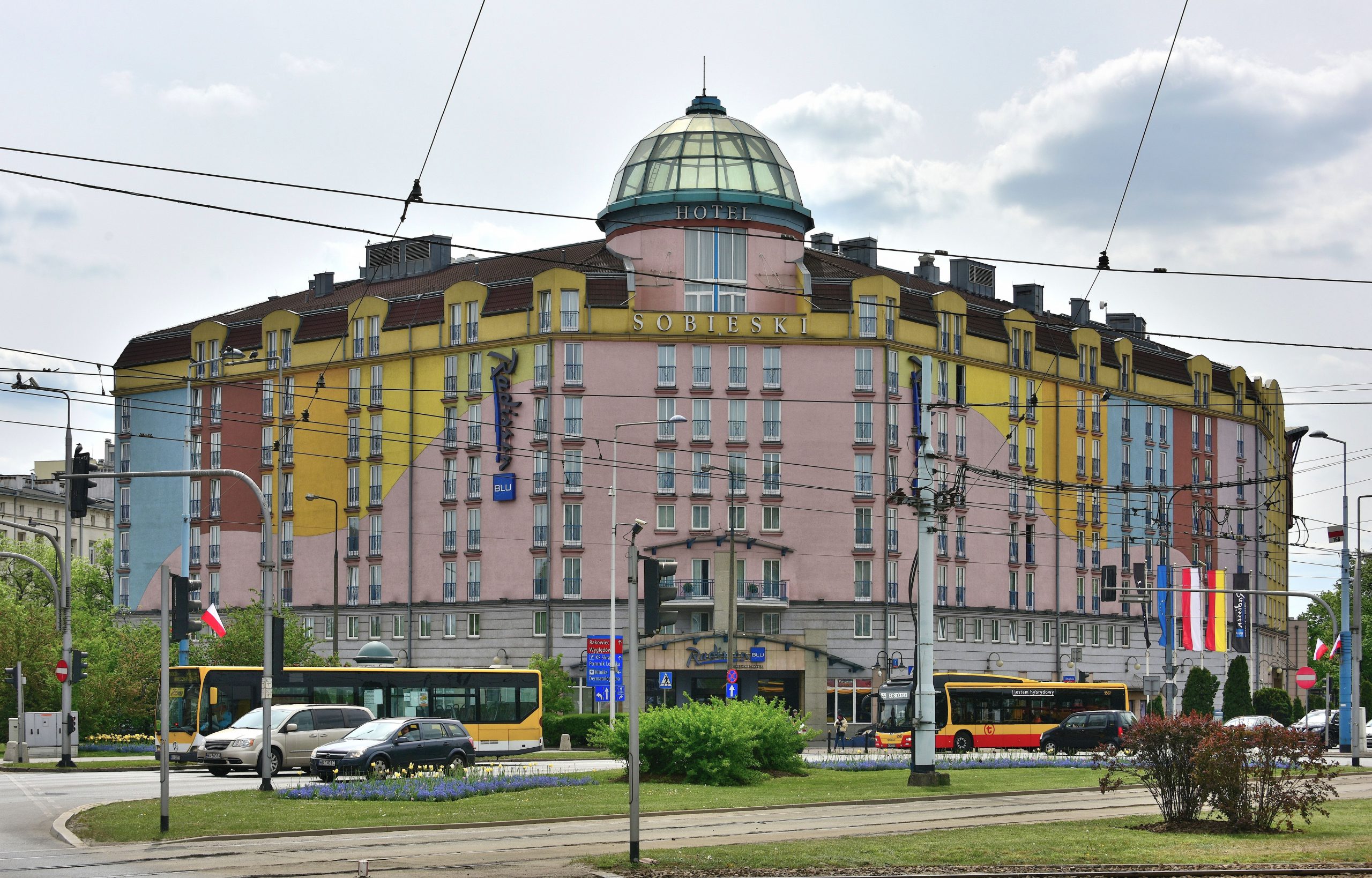
The Sobieski Hotel in Warsaw – opened in 1992 with a pastel-coloured façade typical of the period – was voted the city’s worst building of the 1989-1995 post-communist period in a public poll (Adrian Grycuk/Wikimedia Commons, under CC BY-SA 3.0 PL)
But recent years have seen a backlash against that trend, epitomised by one of Traffic Design’s more iconic projects, the renovation of one of the concrete-panel blocks of flats on Lelewela Street near the centre of Gdynia. Instead of pastel colours, it was painted in light grey, with pink stripes symbolising its prefab past.
Against the backdrop of a patchwork building complex, the block stands out for its simplicity. So much so that it became an instant social media sensation and was even made into the design for a scarf.
Proudly wearing that scarf, Marcin Cybula, a photographer who used to live in the block, says that he appreciates the attention to detail and consistency that characterises the project. He thinks that these small things make life more pleasurable.
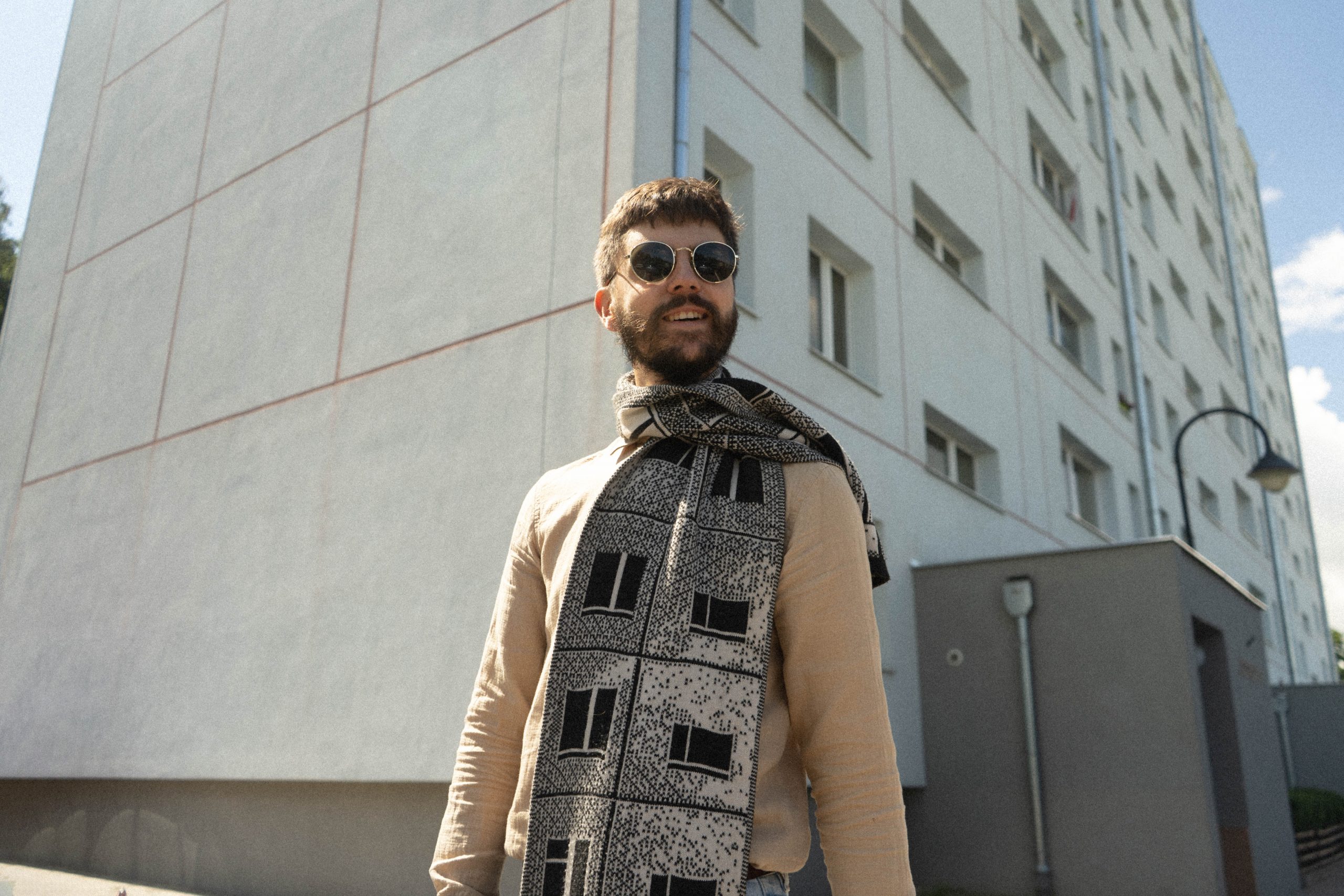
“It became a kind of icon,” he says. “What is even more awesome is that it paves the way for other buildings. It showed that you don’t need to go overboard for the building block to stand out, to be clean and aesthetic.”
Back in Płyta Redłowska, residents of a 1960s apartment building responded with enthusiasm when they found out that Traffic Design had designed a mural for their building.
The deputy chair of their housing association, Dariusz Roman, said that he approved the organisation’s proposal when he saw that it was backed by quality materials and cooperation with good designers. But most importantly, it came at no cost to the community, made up mainly of retirees, and was instead funded by local authorities.
“Advertitis”
But not all housing associations, bodies widespread in Poland, are so lucky. Many have to save for years to afford even basic renovations. Sometimes they try to leverage capitalism to speed up the process by putting large-format advertisements on the walls of buildings, which further clutter the Polish landscape and are the symptom of another “disease” of Polish cities: reklamoza.
For a counterpoint to “people want to make the world beautiful”, Google “reklamoza”. The wrong incentives, social norms etc can ruin things without the right rules. pic.twitter.com/nGsEZbcKLC
— Matt (@phizon) January 23, 2022
“[The ads] are too big, too flashy, too colourful and badly designed,” says Wielebska from Traffic Design. “They disrupt architectural divisions and hide buildings.”
Some Polish municipalities have waged war on advertising by placing tougher restrictions on where they can be placed and how they can look. Sopot, Gydnia’s neighbour, decided to ban billboards completely, a step the city of Kraków has also recently taken.
Sopot, one of Poland's most popular coastal resorts, has removed the last of its billboards in a four-year-long effort to beautify its streets that has seen over 1,000 adverts disappear from public spaces https://t.co/5gSY5ooVYx
— Notes from Poland 🇵🇱 (@notesfrompoland) May 6, 2022
But as well as banning advertising, there are also efforts to make existing signage more aesthetically pleasing – which brings us back to Gdynia and Traffic Design.
Aldek, a small local grocery in the city centre, was launched in the mid-1990s in a housing estate where under communism there had been a Pewex, a symbol of luxury where Poles could buy rare Western goods such as jeans, electronics or cosmetics using US dollars.
The shop, one of the first of its kind, quickly became a key part of the neighbourhood. It offered everything from fresh vegetables, meats and cold cuts to chemicals and cosmetics.
However, when Biedronka, a popular discount retail chain, opened across the street, Aldek’s owners saw their turnover drop. They could not compete with the giant on price or experience in modern retail.
“My parents started a long time ago and did it the way they knew how,” says Marcin Witulski, Aldek’s current co-owner, who inherited the shop from his parents. “At some point, unfortunately, we fell behind.”.
However, as it turned out, customer sentiment towards Aldek was still strong, despite the not-so-aesthetically pleasing window display, which was laced with stock photos of food. When Traffic Design asked the public on social media what projects they should take on next, people were quick to name Aldek.
The subsequent renovation, featuring stylish retro renderings of groceries, was well received among customers, says Witulski, who also now makes sure there are flowers in front of his shop while inside shoppers can use a free book-exchange library.
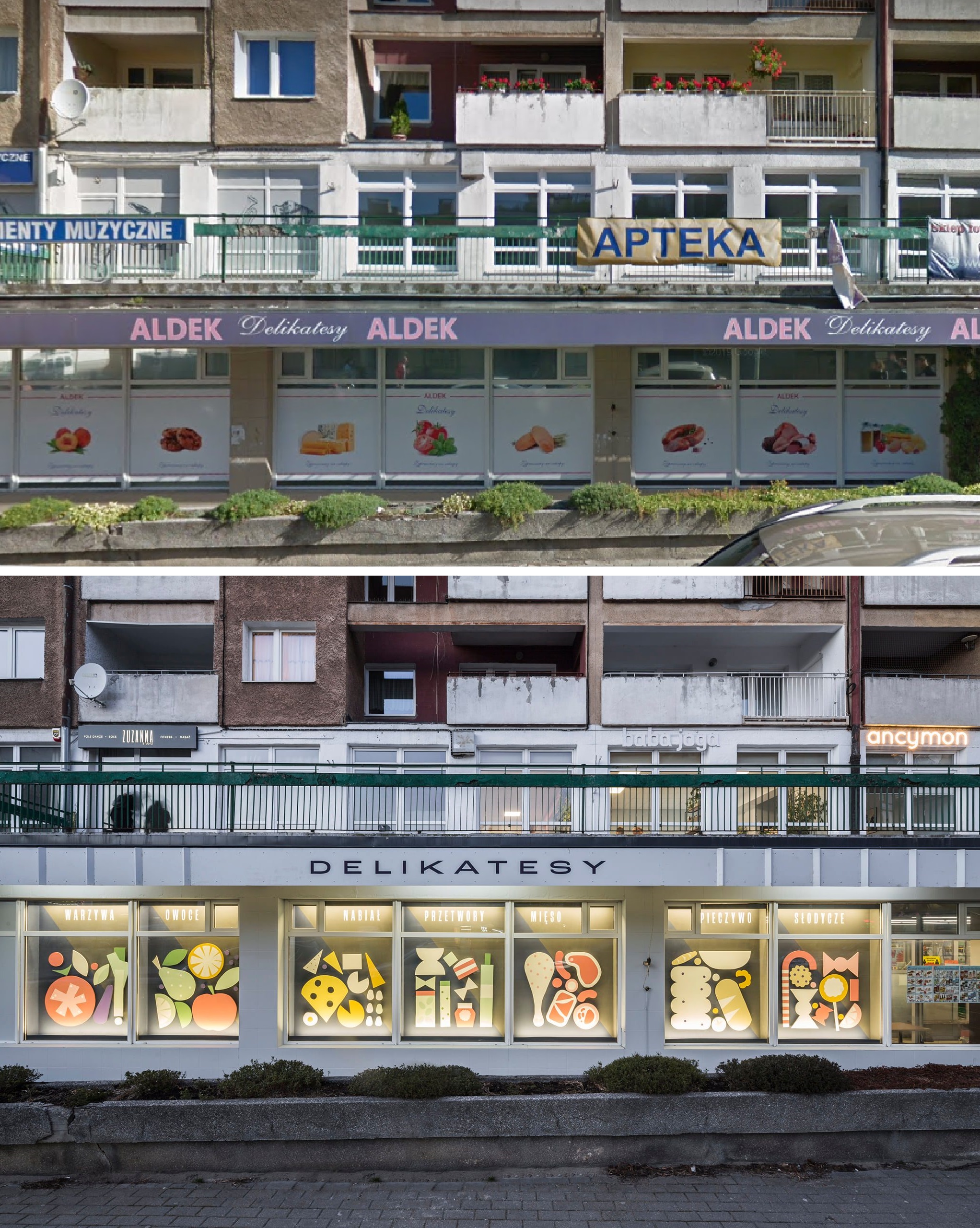
Aldek before and after renovation (image credits: Google Street View; Traffic Design)
In the opinion of Dorota Leśniak, president and co-founder of the Institute of Architecture in Kraków, too much of Poland’s spatial development in the last three decades has been “subordinated to the logic of profit, capital and money” without “thinking about the public interest or the common good”.
She notes that many new developments create closed, gated communities without access to facilities such as schools. This also causes more air pollution through increased car usage, while the resultant “concreting of cities” worsens flooding and creates heat islands.
Concretitis
That brings us to the last of the three ailments afflicting Poland’s urban landscape: betonoza.
Last month, a new square was inaugurated in Warsaw. In the heart of the capital between 19th-century townhouses, city hall decided, in line with the wider trend of giving back urban space to pedestrians, to turn a busy street into a square.
The knocking and the drilling took several months, and while the street was being gutted, the promise of a better city floated in the air. But that promise remained unfulfilled.
Despite the hype, the square turned out to be a large piece of concrete with a few small trees shoved into it like toothpicks.
Trzaskowski ma budżet 21 miliardów złotych rocznie. Mógłby zamienić Warszawę w salon pokazowy osiągnięć Platformy Obywatelskiej – zbudować kontrprojekt wobec rządu. Jedyne co pokazał po 4 latach rządów dziado betonowy parking za 20 milionów złotych. To jest jednak wyczyn. pic.twitter.com/3FWVcqO79n
— Jan Śpiewak (@JanSpiewak) July 5, 2022
The square is part of a wider trend. For years, in Polish towns large and small, central squares have been ploughed over, trees cut down and bushes weeded out, only to be flooded with concrete in what local authorities call “revitalisation” and which often benefits from millions of euros of European funds.
The new squares have not only been greeted with scepticism regarding their aesthetic merits, but also with regard to their impact on the climate amid increasingly frequent extreme weather events.
During heatwaves, concrete heats up to dangerous temperatures – as shown by many urban activists who have cooked eggs on their surfaces. The concrete is also less resistant to flooding, as it prohibits water from naturally soaking into the ground.
Lubaczów, małe miasteczko na Podkarpaciu. #cościeuczyniliztąkrainą #polskabetoniarnia pic.twitter.com/HTHBcOcZtf
— Jan Mencwel (@JanMencwel) June 11, 2019
After a photo of the “revitalisation” of the main square in Leżajsk, a southern Polish town, was widely shared on Twitter, the European Union has said enough is enough.
“EU funds will not support climate unfriendly revitalisations of Polish cities and towns,” said the regional policy branch of the European Commission in Poland.
A victim of history
Almost all the architects, artists and designers Notes from Poland talked to hesitated or refused to say that Poland’s urban landscapes are ugly. Instead, they tended to call the country “a victim of its own history”.
They pointed out that its cities and towns have been shaped not only by Poles’ taste, but also in large part by what the country had to go through: war, occupation, communism then a rapid entry into the wild new world of capitalism.
Marta Przeciszewska, a graphic designer and PhD candidate at Wroclaw Academy of Fine Arts who once worked with Traffic Design, says she finds the Polish landscape inspiring.
“I have a strong feeling that it is unfair to say that Polish cities are ugly. I think they are a bit of a victim of time and the system we live in. But they are not ugly cities,” she said. “They are very Polish.”
Lech from Traffic Design says that “the problem is that in our country for so long a pathological situation has been operating and has become the norm, that [people] treat things that are abnormal as normal. And getting back to doing things well and decently, and with good materials, by people who can do it, is now very difficult.”
But he, like others involved in the field, is hopeful that things are now heading in the right direction. And this process is often driven by residents themselves, notes his partner at Traffic Design, Wielebska.
“You can see that the need is there, and it is so inspiring that people want it to be beautiful around them,” she says. But the process “will take a long time”, she admits.
Main photo credit: Jakub Orzechowski / Agencja Gazeta

Alicja Ptak is senior editor at Notes from Poland and a multimedia journalist. She previously worked for Reuters.
